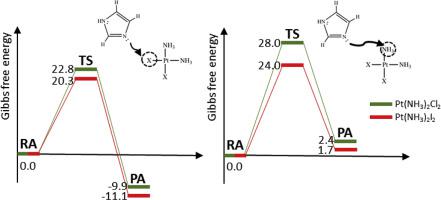Journal of Inorganic Biochemistry ( IF 3.8 ) Pub Date : 2020-05-16 , DOI: 10.1016/j.jinorgbio.2020.111096 Iogann Tolbatov 1 , Tiziano Marzo 2 , Damiano Cirri 3 , Chiara Gabbiani 4 , Cecilia Coletti 1 , Alessandro Marrone 1 , Roberto Paciotti 1 , Luigi Messori 5 , Nazzareno Re 1

|
Quite surprisingly, cisplatin and cis-[PtI2(NH3)2] were found to manifest significant differences in their reactions with the model protein lysozyme. We decided to explore whether these differences recur when reacting these two Pt compounds with other proteins. Notably, ESI-MS measurements carried out on cytochrome c nicely confirmed the reaction pattern observed for lysozyme. This prompted us to exploit a computational DFT approach to disclose the molecular basis of such behavior. We analyzed comparatively the reactions of cis-[PtCl2(NH3)2] and cis-[PtI2(NH3)2] with appropriate molecular models (Ls) of the sidechains of relevant aminoacids. We found that when Pt(II) complexes are reacted with sulfur ligands both quickly lose their halide ligands and then the resulting cis-[Pt(L)2(NH3)2] species loses ammonia upon reaction with a ligand excess. In the case of imidazole, again cis-[PtCl2(NH3)2] and cis-[PtI2(NH3)2] quickly lose their halide ligands but the resulting cis-[Pt(L)2(NH3)2] species does not lose ammonia by reaction with excess imidazole. These results imply that the two platinum complexes manifest a significantly different behavior in their reaction with representative small molecules in agreement with what observed in the case of model proteins. It follows that the protein itself must play a crucial role in triggering the peculiar reactivity of cis-[PtI2(NH3)2] and in governing the nature of the formed protein adducts. The probable reasons for the observed behavior are critically commented and discussed.
中文翻译:

顺铂和顺式[PtI2(NH3)2]与相关蛋白质侧链分子模型的反应:比较分析。
令人惊讶的是,发现顺铂和顺式[PtI 2(NH 3)2 ]与模型蛋白溶菌酶的反应存在显着差异。我们决定探索当这两种Pt化合物与其他蛋白质反应时是否会再次出现这些差异。值得注意的是,对细胞色素c进行的ESI-MS测量很好地证实了观察到的溶菌酶的反应模式。这促使我们利用计算DFT方法来揭示这种行为的分子基础。我们比较分析了顺式-[PtCl 2(NH 3)2 ]和顺式-[PtI 2(NH 3)2 ]和相关氨基酸侧链的适当分子模型(Ls)。我们发现,当Pt(II)配合物与硫配体反应时,都会迅速失去其卤化物配体,然后在与过量配体反应时,所得的顺式-[Pt(L)2(NH 3)2 ]物种会失去氨。在咪唑的情况下,顺式-[PtCl 2(NH 3)2 ]和顺式-[PtI 2(NH 3)2 ]再次迅速失去其卤化物配体,但所得的顺式-[Pt(L)2(NH 3)2 ]物质不会通过与过量的咪唑反应而损失氨。这些结果表明,两种铂络合物在与代表性小分子的反应中表现出明显不同的行为,这与在模型蛋白的情况下观察到的一致。因此,蛋白质本身必须在触发顺式[[PtI 2(NH 3)2 ]的特殊反应性和控制所形成的蛋白质加合物的性质中起关键作用。批判性地评论和讨论了观察到的行为的可能原因。











































 京公网安备 11010802027423号
京公网安备 11010802027423号